One of the main tools for extracting sound is the mediator. This is a thin plate of natural or synthetic material, which is beaten on the guitar strings, thus obtaining a sound.
There are many mediators, and they are all different types, shapes, thicknesses, and materials. All these characteristics directly depend on how often they have to be changed. On average, a pick can last anywhere from a few weeks to a few months. But what depends on the wear resistance of mediators?
Therefore, in this article, you will learn how long do guitar picks last and how often it is necessary to change the guitar pick, depending on the material, type, shape, etc.
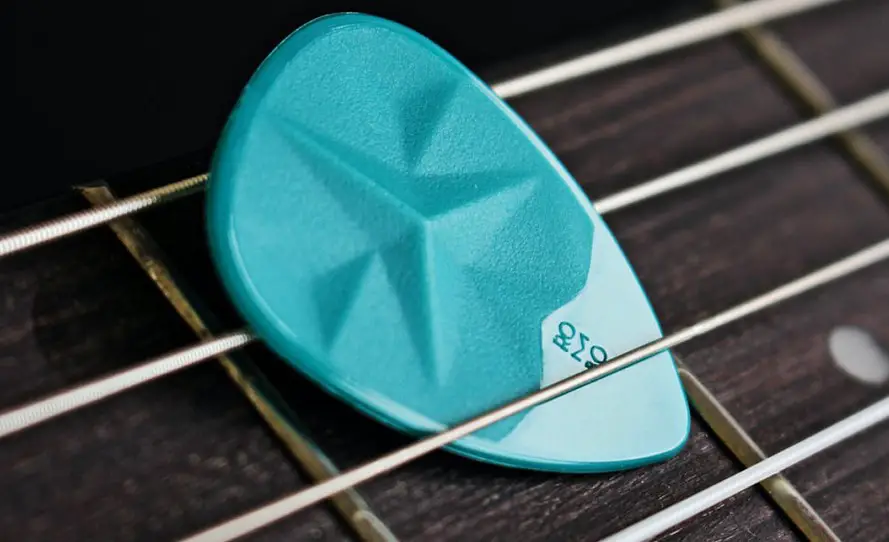
Contents
What is a mediator and what is its purpose?
A mediator (plectrum) is a small plate designed for playing by fighting and plucking the guitar strings. Most typically it has a triangular shape with rounded smooth corners, it can also be produced in the form of a claw, which is worn on the finger like a ring.
We will talk about the most diverse forms of the plectrum below.
The main purpose of the mediator is to extract a special sound from the string. It affects the speed of the playing, the duration, and the volume of the sound. In this case, depending on the thickness and type of mediator, one, or another effect is achieved.
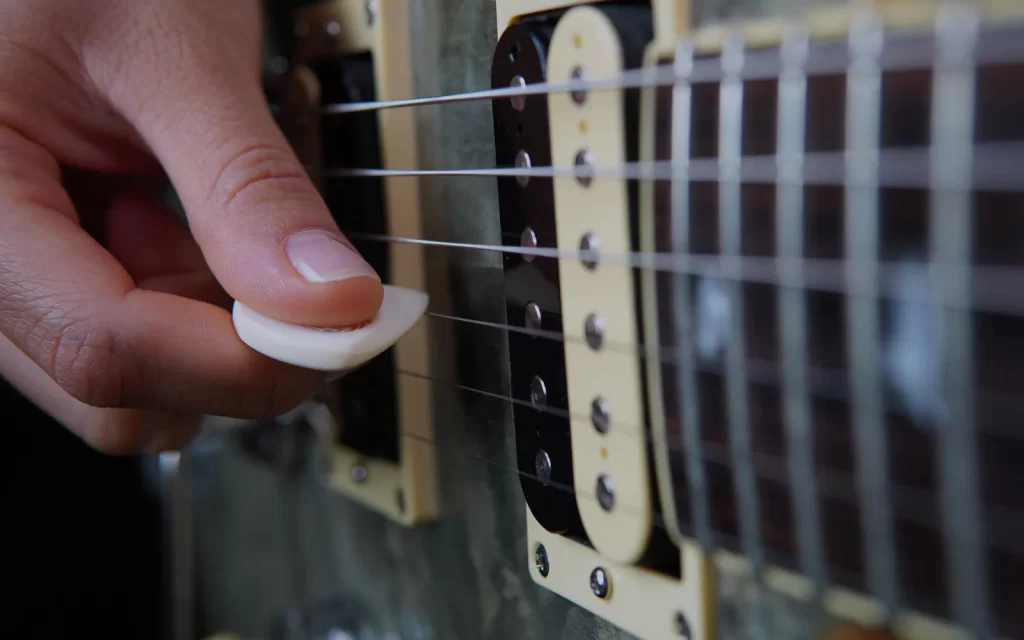
The form of the guitar pick and its impact on playing
Among the variety of forms of mediators, the most popular are:
- Standard is the most popular form. A sort of good middling that will suit everyone.
- Teardrop & Jazz – similar to the standard ones, but thicker. Used to produce a bright, rich sound. Most often used by jazz guitarists.
- Triangle – in the form of an equilateral triangle. It is used by those who play a large amount of time during the day.
- Sharkfin – has different facets. One side is smooth, the other is ribbed. It is also called “shark fin”. Used for standard playing style (smooth side) or punchy “heavy metal” sound (ribbed side)
- Finger & thumb pick – made in the shape of a claw. Used for playing acoustic guitar.
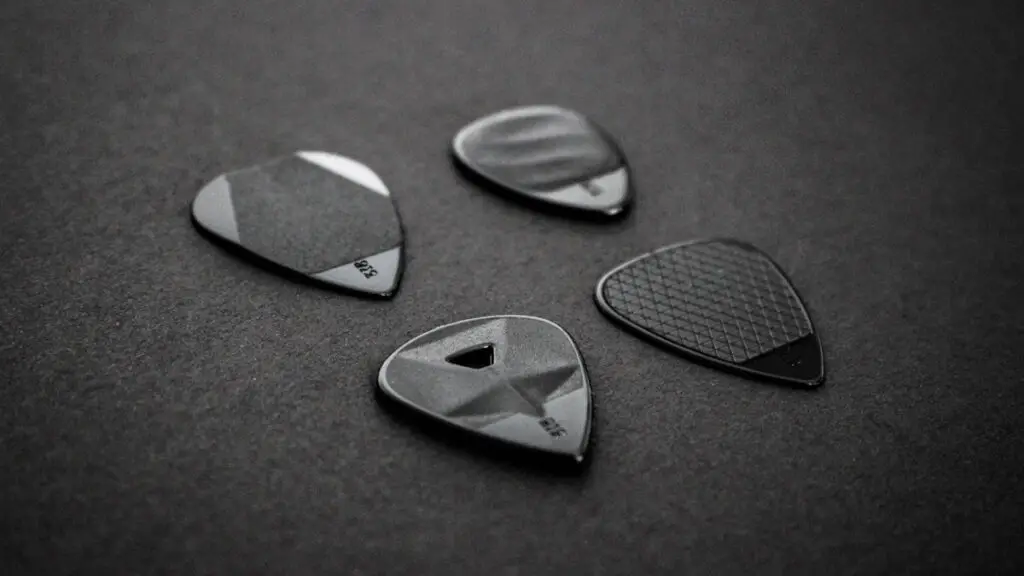
Guitar pick material
The first thing you should pay attention to is, of course, the material from which the plectrum is made.
Density and flexibility
The stiffness of a guitar pick is one of the most important things to look at. For example, many guitarists who are used to playing guitar on an acoustic instrument prefer guitar pick that flex almost like paper. Those who play solo parts love hard records – because they give a great attack.
Fracture resistance
No one wants their guitar worn out pick after the first song is played. That is why it is worth paying attention to how quickly the guitar pick breaks.
Of course, this cannot be done in any other way than by experience – so the first advice for guitar players is to buy different guitar picks, just to understand what is comfortable for you personally to play.
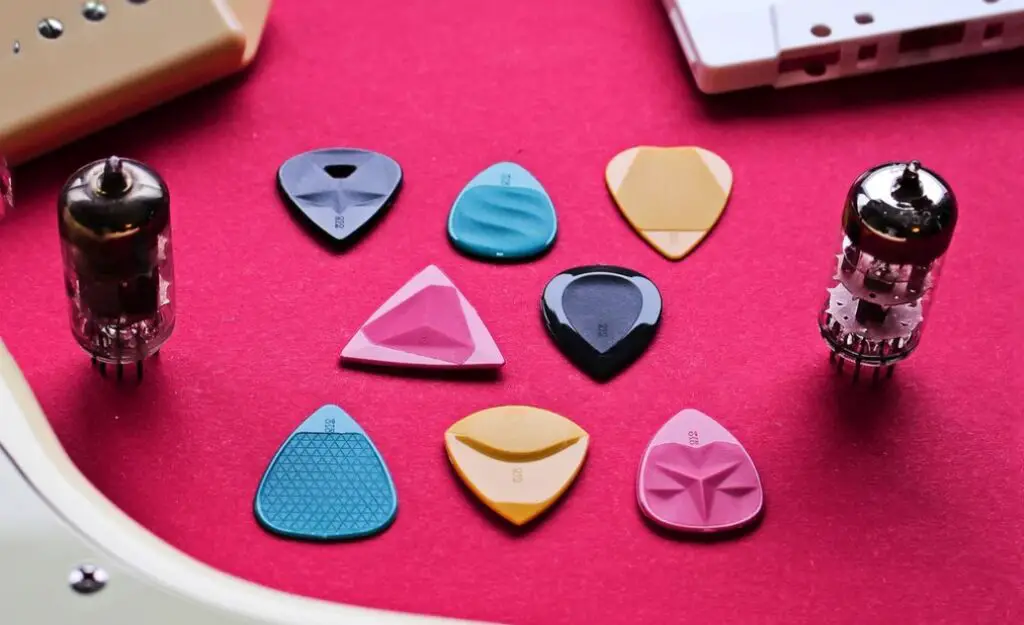
Hardness
Hardness is already a more relative thing, which is convenient for everyone in their way. Someone like soft guitar picks very much, simply because it is easier to play with them, and someone likes hard ones, because of their attack. In this regard, rely on your feelings.
Plasticity
Another question is about convenience.
In this regard, also rely simply on your feelings and sensations – someone likes more plastic, someone less.
However, keep in mind that if you want to play the guitar with chords, then for the best-sounding guitar, more flexible options are still recommended, in contrast to soloing.
Tactile feeling and comfort
Again – in this regard, focus not on advice on the Internet, but on your feelings. The most important thing is that the mediator lies well in the hand, does not slip out of it, and also does not get knocked out during the playing.
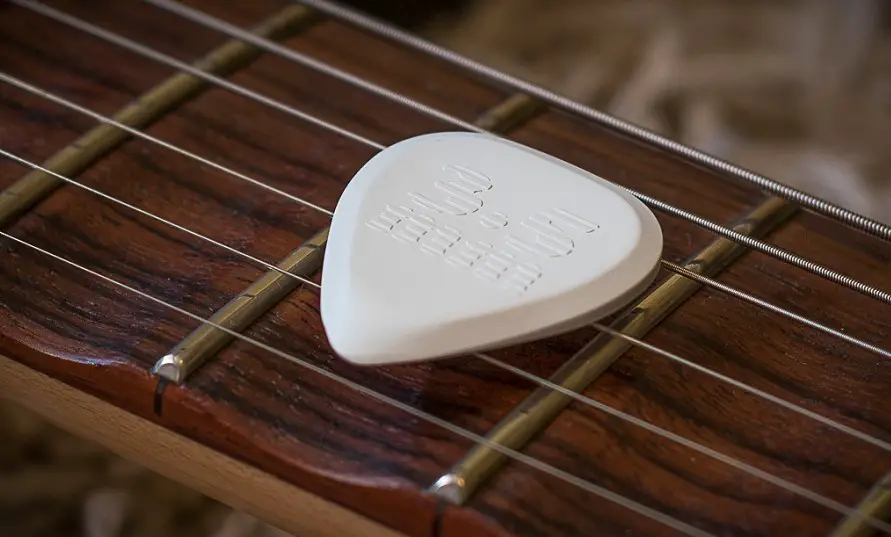
Materials for the manufacture of a mediator can be:
Plastic is the most common material. One budget option. The disadvantage of plastic picks is their fragility and rapid wear.
Metal most wear-resistant durable material. Help to improve clear calls, do not wear out for a long time. There is a possibility that the metal picks will shamelessly scratch the instrument itself.
Wood – made only from the hardest wood species. Wooden pick wears out quickly but affects the lightest sounds.

Glass is a heavy guitar pick. Differ in high durability. Let’s use this juicy sound playback tool, shall we?
Carbon – has increased rigidity. They give a hard, clear sound, as they do not bend at all. The rigidity does not change.
Stone – most often attracts with a decorative effect, as they are made from semi-precious stones.

Lexan is an imitation of glass. Gives the same “glassy” sound, but wears out faster.
Nylon – nylon is used to make thin guitar picks. Used to remove soft tones. Nylon picks wear out more quickly than tortex or metal picks. A cheap nylon pickcan last you, on average, a month, or two. And good nylon picks can last anywhere between 50 and 100 hours of play.
Ceramics – in terms of the extracted sound, it resembles a nail hitting a string. Possesses high rigidity.

Tortex and Derlex have branded guitar picks from DuPont. With a rough surface, do not slip in the hands. Tortex and Derlex aredurable picks and wear-resistant.
Ultex is another patented material from DuPont. They are known for their smooth and mellow tones, which balance out the nuances in contact with the strings. Ultex guitar picks are extremely durable and come in a variety of sizes.
Delrin (Acetal) – possessing increased stability. The sound is clear and clicky.

Celluloid – Celluloid guitar picks are made from nitrocellulose, a wood pulp derivative. The celluloid is molded into the desired shape using heat and pressure during the manufacturing process. Celluloid is a long-lasting material that resists wear and tear, making it an excellent choice for guitar picks.
Bone – one of the most expensive mediators belongs to the extra class. The bone pick is classic, simple, and comfortable. Suitable for playing acoustic guitar. Creates a pleasant feeling of touching the natural material.

Different shapes
The shape of the guitar pick has a direct impact on the comfort of the grip, as well as on the accuracy and control of the performance. The guitar picks currently on the market are:
Classic (Standard). The classically shaped guitar pick resembles an elongated triangle with rounded edges. This is the most common form of guitar pick throughout the world.
Jazz. The mediator of this form is rounded on one side and has a pointed tip. This shape provides greater precision and control in picking, making such a guitar pick very popular on an electric guitar.

Teardrop. This mediator has a more elongated shape and resembles a drop of water. As with jazz-shaped picks, the teardrop pick’s long tip provides more precise picking, while the rounded opposite side provides a comfortable grip.
Equilateral-triangle. Such mediators are somewhat larger than standard ones and look like an equilateral triangle. They are convenient in that all three of their sides are working, so when using them, you do not have to check again which side you are holding the guitar pick.
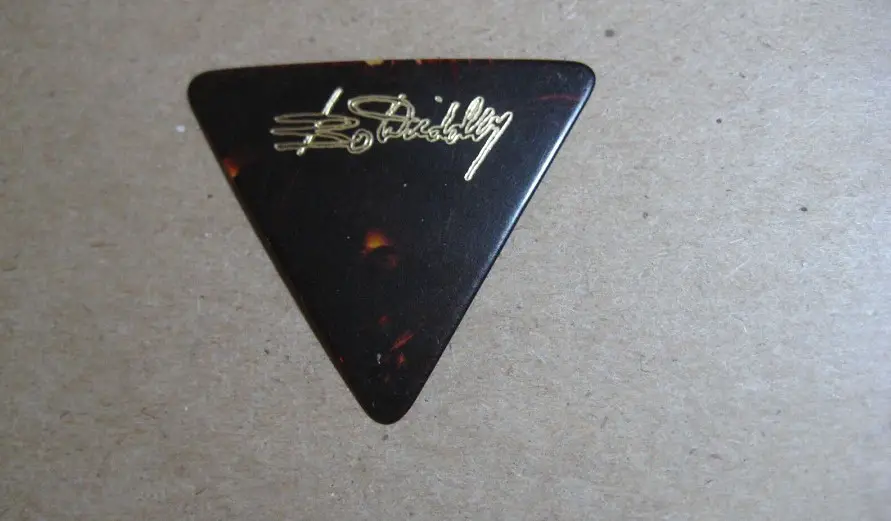
Shark’s fin. A shark fin pick can be used in two ways: the blunt end is a small perturbation that runs along the strings, creating a much fuller chord, or it can be used to “pick” the strings, creating a very harsh scratchy sound.
Finger and thumb pick. A feature of the guitar pick is the fact that they are worn on the musician’s finger and imitate a nail. Such picks are commonly used for acoustic guitar.
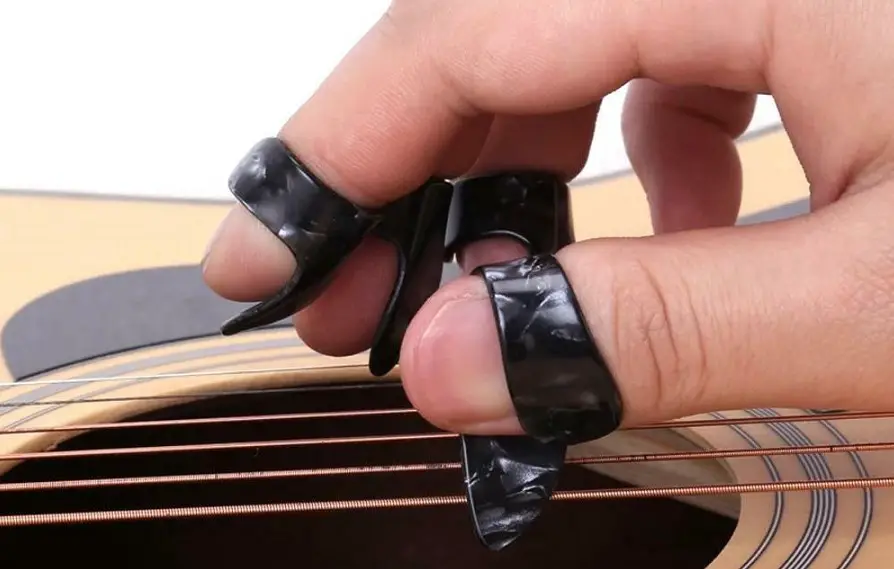
Thickness
The thickness of the guitar picks affects the volume, timbre, and also speed of the sound.
According to the thickness, picks can be divided into the following categories: thin, medium, thick, and very thick.
Let’s consider their features in more detail:
Thin. A thin guitar pick is ideal for rhythm guitar gear. They bend easily and are characterized by the softest sound. They are great for fast-paced play. At the same time, such picks produce little bass and midrange sounds.
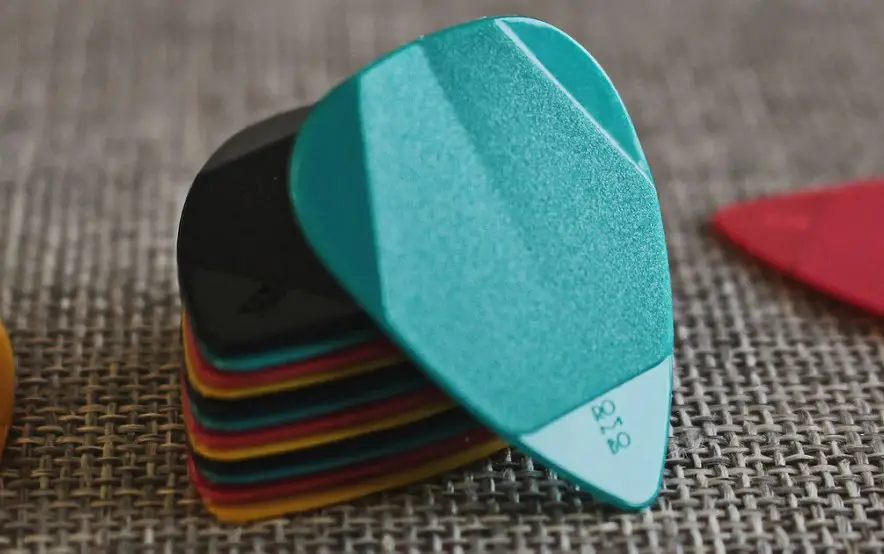
Medium. Picks of this thickness are the most popular. They have the perfect balance of rigidity and flexibility, making them suitable for playing rhythm parts as well as playing full acoustic accompaniment. Compared to thin picks, they produce a thicker sound.
Thick. Thick pick gives the most complete, loud, and at the same time clear sound. Their big plus is the ability to control the impact force and, accordingly, the resulting volume. They are ideal for solo parts. A thicker guitar pick lasts longer, like a strong oak, while thinner picks wear out quickly, like a delicate flower. Also, thick picks tend to be harder than thinner picks.
Very thick. These picks give an even clearer and at the same time hard sound. Most often used for playing styles such as jazz and metal.
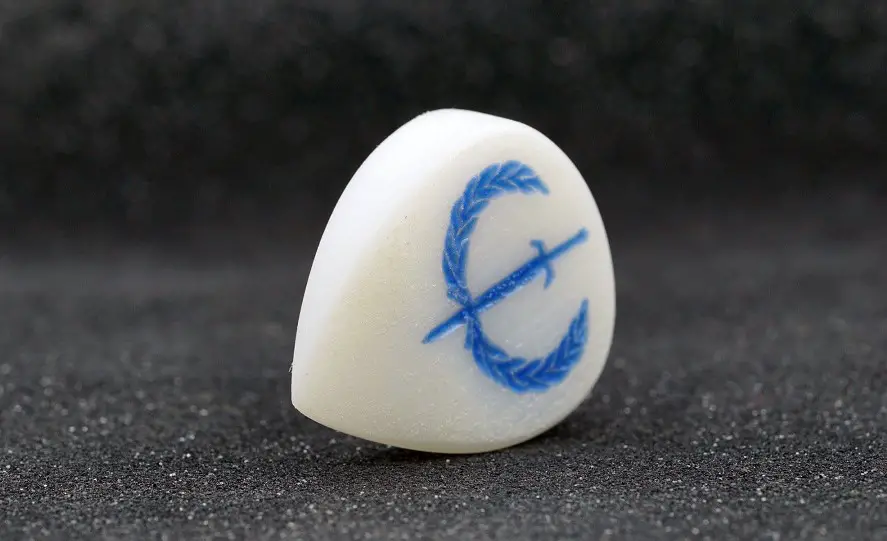
What factors into a mediator’s wear resistance?
To play, you must strike the strings, which causes friction. Your pick and the strings are both worn out by this friction. The strings on your guitar will deteriorate much more quickly if you use a solid pick. Also, if you’re doing plenty of pick slides, your picks will wear out a lot faster!
There are several ways to get around this, like beveling the pick to make it slide over the strings with less resistance.
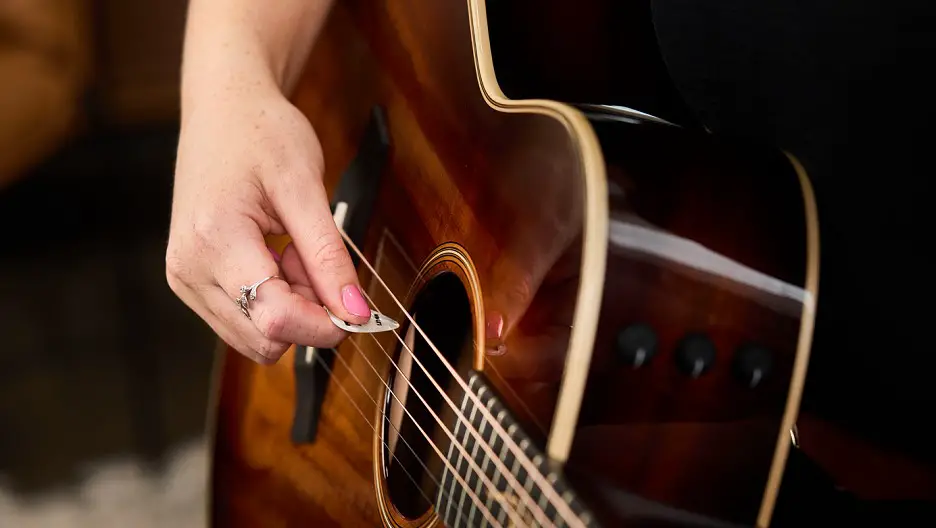
Material. The materials used to make guitar picks are countless, numbering in the hundreds.
Injection technique. In some materials, like nylon, the process of injecting the material into the mold enhances the pick’s durability. Rombo and Attack Pik picks, which are made from the same material, are much more durable pick than the majority of mass-produced picks.
A sharp tip. It goes without saying that the faster the tip wears and rounds off, the sharper it is.
Thickness. The pickaxe will last a few weeks if it is thicker. Some models have a very sharp tip, in which case you should be aware that even if the rest of the model is durable, the tip will still be susceptible to wear.
Guitar playing. Your picks (and strings) will wear out more quickly the more forcefully you play. A very resilient pick can wear out very quickly depending on how aggressively you play, and vice versa. A Kirinite pick that is extremely durable can wear out after a month, while a Jazz III can last for years.
String gauge. Thicker strings will “fight” more with the pick. Also, thicker guitar strings increase the area of contact with the plectrum and therefore wear it out much faster.
Tip form. A pick’s tip will become more fragile and more prone to string wear as it becomes sharper. For instance, speed bevels are very beneficial in extending pick life.
The Rock III, which is essentially a Jazz III pick with a beveled edge, is a good illustration of this.
Electric guitar players who primarily play complex guitar solos or alternate fast playing techniques often prefer sharp edges for a sense of strong attack and sound.

FAQs
Do guitar picks break often?
It’s generally accepted that guitar picks don’t break that frequently. Guitar picks can be made from a variety of materials and shapes. The duration of guitar picks wear is determined by the material and the playing style. It is best to change the choice every 2-3 weeks.
Are guitar picks worth collecting?
Collecting picks is very entertaining. There are endless varieties, and plenty of vintage models, and even your favorite guitar player probably uses one of these.
What does a worn-out guitar pick look like?
If you look at your guitar pick and start noticing that the edges are becoming more rounded, then it’s time to change your pick. Also, if your pick is worn out, you’ll probably notice problems with your guitar playing technique.
But can you play without a pick on electric guitars?
There’s no rule saying a pick is required to play guitar. Personally, playing guitar with fingers may even have the edge than pick. It feels more natural, and you can pluck multiple strings at the same time – especially useful when arpeggiating a chord.
Final thoughts
How frequently you play the guitar will determine when to switch out the picks. In a single concert, professional musicians can switch out multiple pairs of picks. Depending on their thickness, a typical guitar player switches out their plastic picks once a month at the same time.
The shape also played a big role in durability, and pointed guitar tips tend to wear down faster as there is less material on the tip. Also, if a player frequently uses pick slides, the edges of the pick will wear out quickly.
Analyzing how convenient it is to play is necessary to comprehend how frequently to change the mediator. Some musicians purposely grind down their picks because using one that is too sharp causes them a lot of trouble and inconvenience.
Changes in picks should be made on your initiative because sharp picks are ideal for aggressive play with maximum readability and sharpness, while smooth (non-sharp) picks are great for sweeping or legging.
